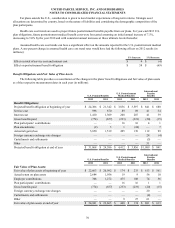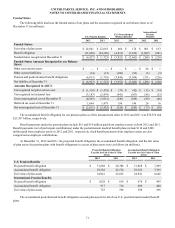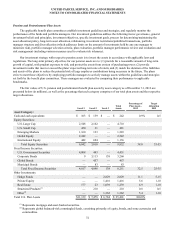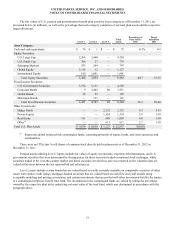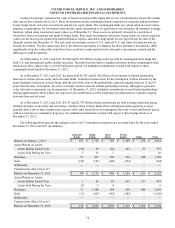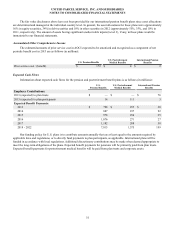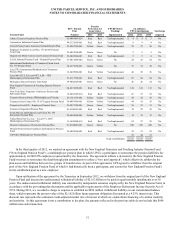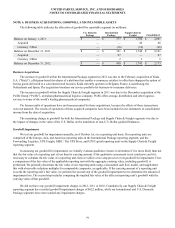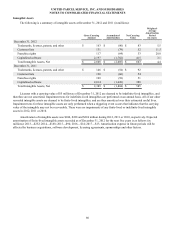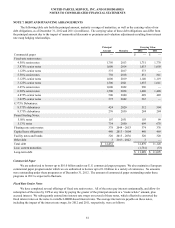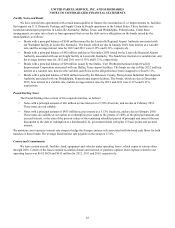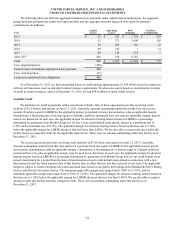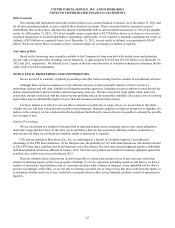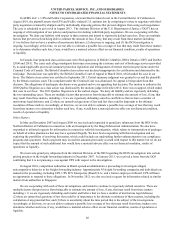UPS 2012 Annual Report Download - page 88
Download and view the complete annual report
Please find page 88 of the 2012 UPS annual report below. You can navigate through the pages in the report by either clicking on the pages listed below, or by using the keyword search tool below to find specific information within the annual report.UNITED PARCEL SERVICE, INC. AND SUBSIDIARIES
NOTES TO CONSOLIDATED FINANCIAL STATEMENTS
76
NOTE 5. MULTIEMPLOYER EMPLOYEE BENEFIT PLANS
We contribute to a number of multiemployer defined benefit plans under the terms of collective bargaining agreements that
cover our union-represented employees. These plans generally provide for retirement, death and/or termination benefits for eligible
employees within the applicable collective bargaining units, based on specific eligibility/participation requirements, vesting periods
and benefit formulas. The risks of participating in these multiemployer plans are different from single-employer plans in the following
aspects:
• Assets contributed to the multiemployer plan by one employer may be used to provide benefits to employees of other
participating employers.
• If a participating employer stops contributing to the multiemployer plan, the unfunded obligations of the plan may be borne
by the remaining participating employers.
• If we choose to stop participating in some of our multiemployer plans, we may be required to pay those plans an amount
based on the underfunded status of the plan, referred to as a withdrawal liability. However, cessation of participation in a
multiemployer plan and subsequent payment of any withdrawal liability is subject to the collective bargaining process.
The discussion that follows sets forth the financial impact on our results of operations and cash flows for the years ended
December 31, 2012, 2011 and 2010 from our participation in multiemployer benefit plans. Several factors could cause us to make
significantly higher future contributions to these plans, including unfavorable investment performance, changes in demographics and
increased benefits to participants. However, all surcharges are subject to the collective bargaining process. At this time, we are unable
to determine the amount of additional future contributions, if any, or whether any material adverse effect on our financial condition,
results of operations or liquidity would result from our participation in these plans.
The number of employees covered by our multiemployer plans has remained consistent over the past three years, and there have
been no significant changes that affect the comparability of 2012, 2011 and 2010 contributions. We recognize expense for the
contractually-required contribution for each period, and we recognize a liability for any contributions due and unpaid at the end of a
reporting period.
Multiemployer Pension Plans
The following table outlines our participation in multiemployer pension plans for the periods ended December 31, 2012, 2011
and 2010, and sets forth our calendar year contributions into each plan. The “EIN/Pension Plan Number” column provides the
Employer Identification Number (“EIN”) and the three-digit plan number. The most recent Pension Protection Act zone status
available in 2012 and 2011 relates to the plans’ two most recent fiscal year-ends. The zone status is based on information that we
received from the plans’ administrators and is certified by each plan’s actuary. Among other factors, plans certified in the red zone are
generally less than 65% funded, plans certified in the orange zone are both less than 80% funded and have an accumulated funding
deficiency or are expected to have a deficiency in any of the next six plan years, plans certified in the yellow zone are less than 80%
funded, and plans certified in the green zone are at least 80% funded. The “FIP/RP Status Pending/Implemented” column indicates
whether a financial improvement plan (“FIP”) for yellow/orange zone plans, or a rehabilitation plan (“RP”) for red zone plans, is
either pending or has been implemented. As of December 31, 2012, all plans that have either a FIP or RP requirement have had the
respective FIP or RP implemented.
Our collectively-bargained contributions satisfy the requirements of all implemented FIPs and RPs and do not currently require
the payment of any surcharges. In addition, minimum contributions outside of the agreed upon contractual rate are not required. For
the plans detailed in the following table, the expiration date of the associated collective bargaining agreements is July 31, 2013, with
the exception of the Automotive Industries Pension Plan and the IAM National Pension Fund / National Pension Plan which both have
a July 31, 2014 expiration date. For all plans detailed in the following table, we provided more than 5% of the total plan contributions
from all employers for 2012, 2011 and 2010 (as disclosed in the Form 5500 for each respective plan).
Certain plans have been aggregated in the “All Other Multiemployer Pension Plans” line in the following table, as the
contributions to each of these individual plans are not material.






